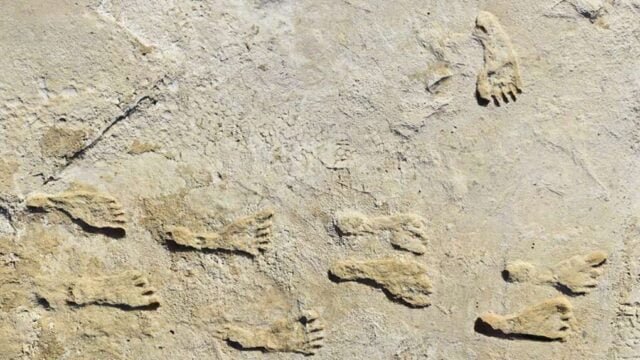
In a groundbreaking discovery, new research has unveiled that humans might have migrated to the Western Hemisphere much earlier than previously believed. This revelation stems from the analysis of ancient footprints found in New Mexico’s White Sands National Park, which are now believed to be approximately 23,000 years old. These footprints are now considered the oldest evidence of human presence in the Americas.
Key Highlights:
- The footprints in White Sands National Park are dated to about 23,000 years ago.
- This discovery challenges the earlier belief that humans arrived in the Americas towards the end of the Ice Age via the Bering Land Bridge.
- The footprints were first discovered in 2009 along the shore of a prehistoric lake.
- As of November 2021, 61 human prints were identified, along with prints from mammoths, ground sloths, dire wolves, and American lions.
- The age of the footprints was confirmed through radiocarbon dating of conifer pollen mixed with the footprints and luminescence dating of quartz grains within the sediments.
Unraveling the Mystery:
The footprints at White Sands were initially discovered in 2009, and by November 2021, a total of 61 human prints had been identified. These footprints were not alone; they were accompanied by prints from mammoths, ground sloths, dire wolves, and American lions. The earlier 2021 study had estimated the age of these human tracks to be between 23,000 and 21,000 years ago. This estimation was based on radiocarbon dating of aquatic plant seeds found intermingled with the prints. However, this finding sparked widespread debate regarding the accuracy of the dating.
Confirming the Age:
Skeptics of the initial findings proposed that the aquatic seeds might have absorbed old carbon from groundwater or could have been embedded in sediment and later exhumed by early humans. To address these concerns, the recent research confirmed the age of the seeds by radiocarbon dating conifer pollen that was also present with the footprints. Additionally, luminescence dating was conducted on quartz grains within the sediments. The results were compelling. The age of the pollen matched the age of the seeds, and the quartz samples indicated a minimum age of 21,500 years ago.
Insights from the Footprints:
The footprints have provided a unique window into the lives of the ancient humans who left them behind. Most of the prints were from teenagers and children. Scientists hypothesize that these younger individuals might have been more active, possibly fetching items for adults working at the lake’s edge. Intriguingly, footprints believed to belong to a female, stretching for almost a mile, suggested that she had recently given birth, as toddler footprints occasionally appeared beside hers.
Summary:
The discovery of ancient footprints in New Mexico’s White Sands National Park has significantly altered our understanding of human migration to the Americas. Previously believed to have arrived towards the end of the Ice Age, new evidence suggests that humans might have been present during the peak of the last Ice Age, approximately 23,000 years ago. This research not only challenges established timelines but also provides a fascinating glimpse into the lives of our ancient ancestors.








